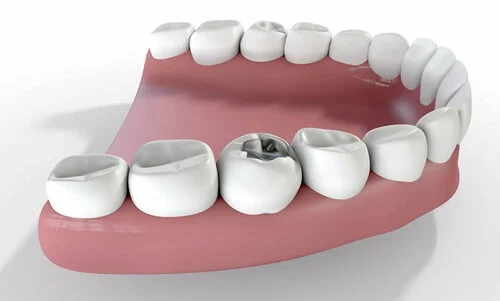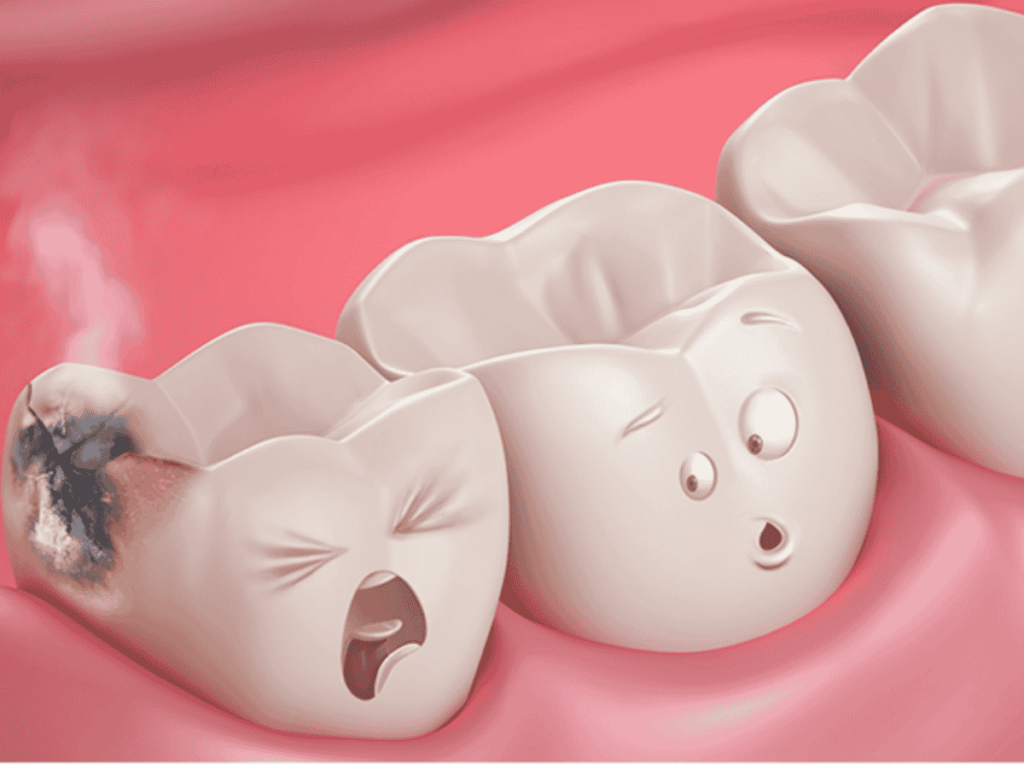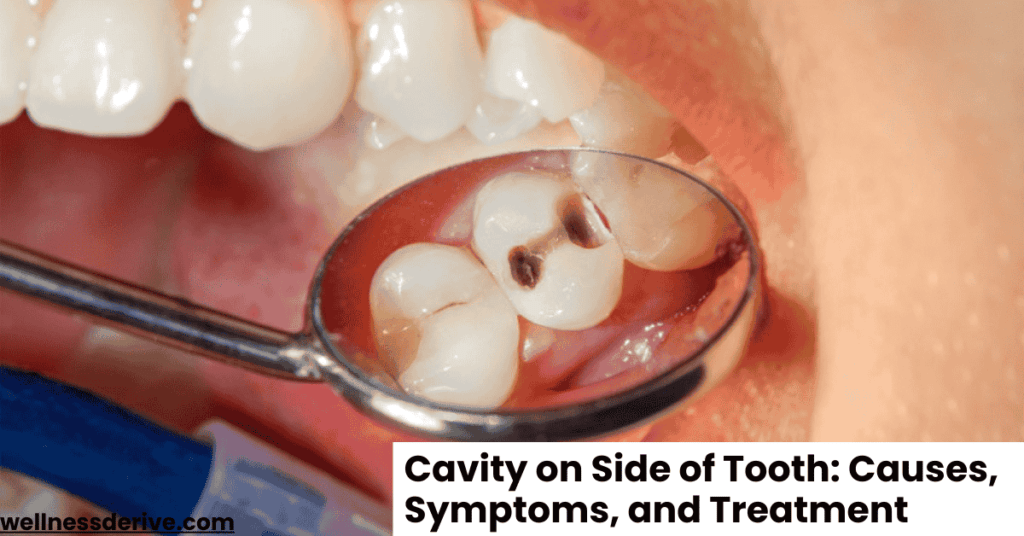A cavity on the side of a tooth occurs when bacteria and plaque accumulate in areas that are harder to clean. Unlike cavities on the chewing surface, which are easier to spot, side cavities often go unnoticed until they cause discomfort or visible damage. These cavities can develop between teeth or along the outer edges of molars, making them particularly tricky to detect without a dental exam.
Cavities on the side of a tooth are caused by poor oral hygiene, frequent consumption of sugary or acidic foods, and lack of proper flossing. Because these areas are harder to reach with a toothbrush, plaque builds up, leading to enamel erosion and eventual decay. If left untreated, the cavity can spread deeper, causing pain, sensitivity, and the need for more extensive dental treatment.
Also Read: Can You Kill Tooth Pain Nerve in 3 Seconds Permanently?
Causes of a Cavity on the Side of a Tooth
A cavity develops when harmful bacteria feed on food particles and produce acid, which erodes the tooth enamel. The sides of the teeth are especially vulnerable because food and plaque can easily get trapped in these tight spaces.
One of the leading causes of side cavities is poor flossing habits. When food remains lodged between the teeth, bacteria multiply, accelerating the decay process. Additionally, drinking sugary or acidic beverages frequently weakens the enamel, making the teeth more prone to cavities.
People who wear dental braces or aligners may also be at a higher risk of developing side cavities because food particles can become trapped around the brackets and wires. Furthermore, gum recession due to aging or gum disease can expose more of the tooth surface, making it easier for cavities to form along the edges.
Symptoms of a Cavity on the Side of a Tooth

Detecting a side cavity early is essential to prevent further complications. Since these cavities often develop between teeth, they may not be visible until they reach an advanced stage. However, there are some signs to watch for:
- Tooth sensitivity: Discomfort when consuming hot, cold, or sweet foods.
- Pain when chewing: A sharp or dull pain on one side of the mouth.
- Rough edges on the tooth: A noticeable difference in texture along the side of the affected tooth.
- Dark spots or discoloration: Brown, black, or white spots near the cavity.
- Food getting stuck: Frequent trapping of food between certain teeth.
If you notice any of these symptoms, it’s important to visit a dentist as soon as possible. Early treatment can prevent the need for more invasive procedures like root canals or tooth extractions.
How to Treat a Cavity on the Side of a Tooth
The treatment for a cavity on the side of a tooth depends on how advanced the decay is. A dentist will assess the severity and recommend the most suitable option to restore the tooth.
Common Treatments for Side Cavities
- Fluoride Treatment: If the cavity is in its early stage, fluoride can help remineralize the enamel and stop further decay. This is most effective for tiny holes on the side of a tooth.
- Dental Filling: When the cavity has progressed beyond the enamel, a dentist will remove the decayed portion and fill it with a composite resin, amalgam, or ceramic filling.
- Bonding: For small cavities along the outer edges of a tooth, bonding material can be applied to restore the tooth’s shape and protect it from further damage.
- Inlays or Onlays: If the decay is larger than what a simple filling can repair, inlays or onlays may be used to strengthen the affected tooth.
- Dental Crown: In severe cases where a significant portion of the tooth is affected, a crown may be placed to cover and protect the tooth structure.
If a cavity is left untreated for too long, it can reach the inner pulp of the tooth, requiring a root canal or extraction to remove the damaged tissue and prevent infection.
Also Read: What Happens If You Swallow a Tooth?
What Happens If You Ignore a Cavity on the Side of Your Tooth?

Leaving a side cavity untreated can lead to serious consequences. As decay spreads deeper, the pain and discomfort worsen, making it difficult to chew or consume certain foods. The bacteria can also spread to neighboring teeth, increasing the risk of additional cavities.
If the decay reaches the tooth’s nerve, it may lead to a painful infection that requires a root canal treatment. In extreme cases, when the damage is beyond repair, the affected tooth may need to be extracted.
Ignoring a cavity can also result in bad breath, abscess formation, and even jawbone damage. Seeking timely treatment can save your tooth and prevent more extensive dental procedures.
Also Read: How to Fix a Cracked Tooth Naturally
How to Prevent Cavities on the Side of a Tooth
Maintaining good oral hygiene is the best way to prevent cavities on the sides of your teeth. While brushing alone isn’t always enough, incorporating additional cleaning habits can help reduce the risk of tooth decay.
Effective Ways to Prevent Side Cavities
- Floss daily to remove food particles and plaque between teeth.
- Use fluoride toothpaste to strengthen enamel and prevent decay.
- Limit sugary and acidic foods that weaken the enamel.
- Drink plenty of water to wash away food debris and bacteria.
- Visit your dentist regularly for professional cleanings and early cavity detection.
For individuals with a higher risk of cavities, dental sealants or fluoride treatments may be recommended by a dentist to add an extra layer of protection.
FAQs About Cavities on the Side of a Tooth
Final Thoughts
A cavity on the side of a tooth may seem minor at first, but without treatment, it can lead to serious dental problems. Regular checkups, proper brushing and flossing, and a healthy diet can significantly reduce the risk of cavities and help maintain a strong, healthy smile.
If you notice any signs of a side cavity, seeking prompt dental care can prevent pain, infection, and extensive treatments. Keeping your teeth clean and following good oral hygiene habits is the best way to protect your smile for years to come.
Disclaimer: The content on Wellness Derive is for informational purposes only and not a substitute for professional medical advice, diagnosis, or treatment. Always consult a healthcare provider for medical concerns.



